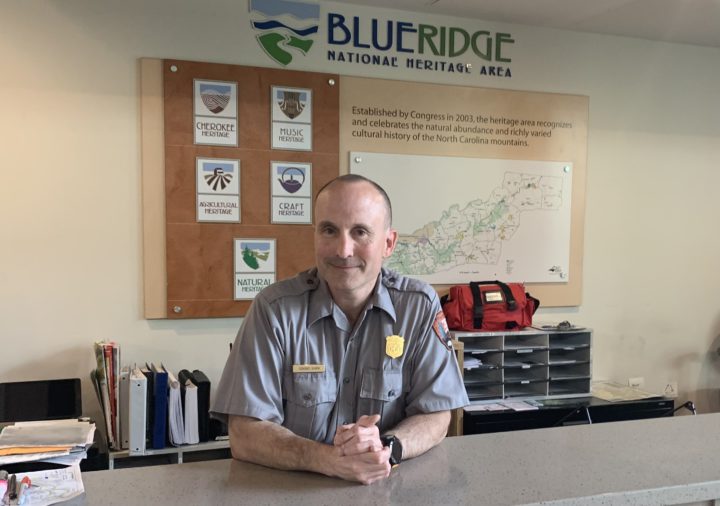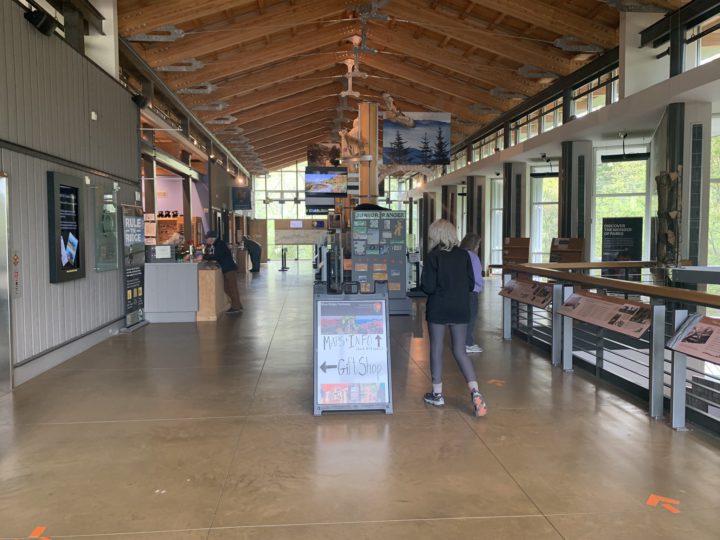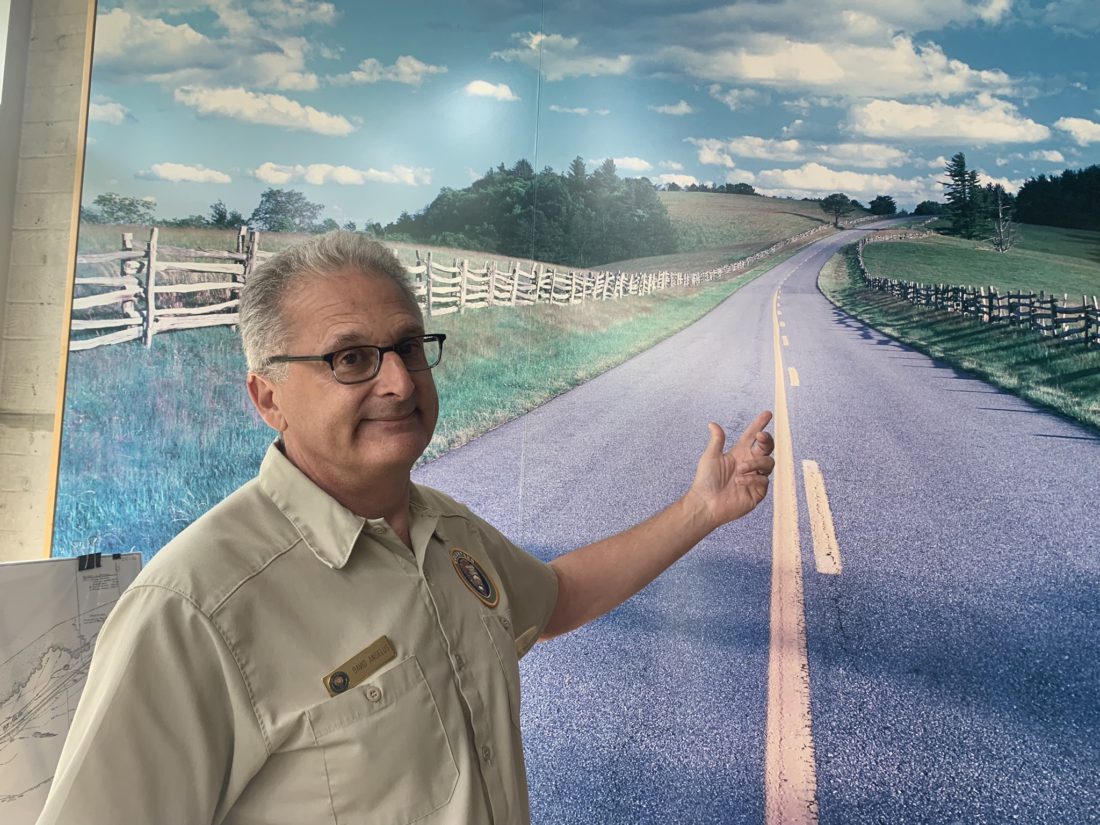I’ve driven the Blue Ridge Parkway plenty of times in my five years in Asheville — sometimes to get somewhere else, sometimes just for the pleasure of the road. I’ve marveled at the outrageous orange fall leaves, wowed at the spring flowers and hiked trails snaking off into the trees.
I know this is a special place, but not long ago, while my brother was in town, he asked about the parkway. Specifically, he asked what it was and what there was to do there.
“It’s a … park?” I said. “Or maybe it’s a road? You just, like, drive on it? And then hike off it? Or on it?”
Which, let’s be honest, is both kind of an embarrassing answer and strangely similar to the bumbling responses friends have offered me when I’ve posed the question.
When I talk to Leesa Sutton Brandon, the external affairs specialist for the Blue Ridge Parkway, she says that the most obvious thing she wants people to know is that the Blue Ridge Parkway is a national park, like the Grand Canyon and Arches. (Which, if I’m being honest, I did not realize, either.)
So, I have decided to spend the day at the Blue Ridge Parkway Visitor Center, Milepost 384, planting myself in the heart of it, among the people who will be able to answer what exactly this place is, who is coming here and why.
A hike before Biltmore
It is a Wednesday morning in early spring. The sky is a mix of sun and light gray clouds, and the visitor center has just opened. A few people are milling about the big room, enjoying the taxidermy black bear and bobcat as well as the informative panels on the plight of the American chestnut.
Conrad Shirk, an interpretative park ranger with buzzed hair and smile crinkles around his eyes, stands behind the main desk in his uniform and the kind of big outdoorsy watch that suggests expertise. I ask him what kind of questions he gets most.
“‘What should I do here?’ That’s the basic question,” he tells me.
Almost immediately, he answers this exact inquiry for a couple. They look to be in their 70s, very fit. They lean over the ranger’s desk in matching muted orange T-shirts, both with their socks pulled up midcalf.
That this sock style has become a shorthand for doing “outdoorsy” things always strikes me as funny. I can guess that the purpose is to keep ticks or unwelcome plants from your ankles, but most of the trails here are exquisitely maintained, with nary an overgrown patch. But maybe, like with so many things, there is comfort in wearing the uniform. You can say to yourself, “Today, I can climb the mountain.”
Ranger Shirk offers the couple a few suggestions. Two minutes up the road is the Folk Art Center, and then there’s Craggy Gardens, the most popular stop on the parkway. There’s also Mount Mitchell — the highest peak east of the Mississippi River.
He continues: You can stop in at Little Switzerland, “adorable, like an actual little Switzerland,” or drive the Linn Cove Viaduct, those beautiful curves you see when you look at pictures of the Blue Ridge Parkway. The 7-mile stretch was the last portion of the parkway to be completed in 1987, after much negotiation involving environmentalists, adjacent landowners and engineers to make sure the roadway did not disrupt the section’s fragile ecosystem.

“People know it’s beautiful, but beyond that, they don’t know what to do here,” Shirk tells me after the couple proceed out into the parking lot, map in hand. “They want to know where to see good big views and then where to hike — which always comes with a lot of follow-up questions from me about mileage and elevation. And then — and here’s the big one — what to do before their time slot at the Biltmore.”
In my hours at the visitor center, I will hear this last question — fitting in parkway activities around Biltmore ticket scheduling — from maybe 70% of the people who come in.
Enthusiastic travelers
I soon meet David Angelus, who bubbles over to me with an impressive mix of enthusiasm and factoids. He’s the lead volunteer, who was “voluntold,” he says, to oversee all 60 fellow volunteers.
Angelus is six years into his position and is clean-shaven, with cropped gray hair and black-framed glasses. A former JPMorgan Chase banker previously based in Chicago, he shares his terrific ability to recall facts with visitors for two hours at a time. He is the kind of guy who answers the question, “Where’s the closest gas station?” with “Well, in the early 1900s …”
“Can I help you?” he asks a middle-age woman peering at a wall-length map of the full parkway.
“Are you kidding me?” she says. “I’ve had everything planned out to the minute for months.”
The woman, wearing a perfectly clean white visor, is on her five-night, 30th-anniversary trip, she tells me, during which she and her husband will drive all the way up the parkway to Virginia. Though the couple lives in nearby Knoxville, Tenn., they love these mountains, she says. They wanted more time.
Another couple is lingering near a display on traditional folk music. Unlike most visitors, this pair is young and carries with them their 6-month-old baby, who is first sleeping before blinking happily inside his car seat.
They’re from Virginia and are self-described parkway devotees. In their time together, they’ve driven all of its northern and southern stretches. Their current trip, which they’ve just completed as they arrive at the visitor center, concludes the whole parkway.
They don’t hike as much now as they once did, they say, but they stopped at a few overlooks and did a couple of short walks. Their favorite part is down near Cherokee.
“I mean it’s all beautiful,” the woman clarifies quickly, leaning down to rearrange the blanket on her baby. “It’s all just really so beautiful.”
‘I want to see a bear’
The idea for this 469-mile stretch was conceived in 1933 after President Franklin Delano Roosevelt visited Skyline Drive in Virginia. Though most of the parkway’s construction was carried out by private contractors, several New Deal public works programs were also employed.
Over the subsequent decades, the national park’s popularity has continued to grow. According to the parkway’s most recent numbers, it had nearly 16 million visitors in 2022.
Part of its appeal is its uniqueness. The park is the road; the road is the park. Unlike other sites, where car access was at some point fitted into an already stunning landscape, such as the Grand Canyon or the Great Smoky Mountains, the entirety of the Blue Ridge Parkway itself was fabricated with the intention of being the park.
This has meant that despite the absolute splendor of these blue hazy mountains, black bears and changing trees, the messaging about what exactly this park offers can be a little harder to parse.
Most people are just passing through, using the road to connect the Smokies and the Shenandoah in Virginia, Angelus tells me. “They come in here and just say, ‘I want to see a bear,’” he says. “I can show them a bear on my phone, I’ve got tons of pictures.”
One of the jobs of the rangers and volunteers is to “protect people from themselves,” Angelus explains. Black bears are not aggressive toward humans; nearly all problems between people and the area’s bear population come from human error. And it’s all the usual stuff, Angelus explains — people trying to get too close to the bears or trying to give them treats or leaving food in unlocked cars despite all the warnings.
Angelus says the parkway is launching a new initiative to further educate the public about bear safety, particularly as it relates to dogs. The reason to keep your dog on leash has more to do with collective safety. It turns out that once a bear is frightened by a pup, it will associate all future canine encounters — leashed or unleashed — as a threat and will attack. There have been some recent leashed dogs killed this way, Angelus notes.
But most of the misadventures the volunteers and rangers encounter are of a less traumatic variety, he continues: bee stings, ankle sprains, dead car batteries.
The digital age
A woman in her late 20s or early 30s pops in. She’s beaming and beelines to Angelus, holding out her national park passport book. Where can she find the stamp? she asks him. He directs her to the appropriate area.
I ask Angelus if they get a lot of these requests.
He squints, frowns.
“Not a lot of young people in general,” he says. “She’s probably someone who had the passport book as a kid and came back to it with some kind of nostalgia. But mostly when young people come in here, you know what they’re interested in?”
Here, he mimics someone walking with their head down, staring at their moving fingers.
“Phones,” he continues. “It’s all phones.”
He sighs and looks out the window. “All I want is for this place to be here for a long time. Not for our kids or their kids, but after that.”
I ask him how he thinks that might happen.
“We’ve got to embrace the young people,” he says. “Bring things online. Connect with the digital age.”
The lone local
There’s a rush in the morning, and then a steady trickle as we move toward midday. I love the variety of people coming in. A retired couple on their way back to Chicago take turns putting their arms around each other as they lean over the maps and look at the display marked “The Hey-Day of Auto Touring.”
A man in full black leather motorcycle gear enters. He’s wearing boots and a reflective stripe piping his jacket for safety. He looks at a few signs and then uses the bathroom.

Another solo traveler is milling about. He wears a brown sweater vest, brown plaid shirt beneath it, brown slacks and a brown plaid hat. I try to meet his eye, to ask what he is doing here and compliment his dapper dress, but his black-frame glasses are glued to the historical display he’s examining, and I chicken out.
In the parking lot, a couple stand under an umbrella with a small cardboard bookshelf in front of them. “Free Bible course” a sign reads. They make eager eye contact whenever I look over, though I never see anyone else talking to them.
I overhear two couples speaking French. I listen to Angelus tell anecdotes about the area’s critical species at least a dozen times. I talk to people from Nashville, visitors from Michigan, two bikers from Montgomery, a duo on their way to Connecticut, a German traveler and then finally, a woman from right here in Fletcher.
She’s the only other local I encounter all day.
Winner’s secrets
Dennis Winner arrives at 11 a.m. to take over the volunteer role. He’s an 82-year-old Asheville native who has been hiking these trails since he was a kid. He wanders away for a moment and Angelus leans in close.
“He’s a guy you should really talk to,” Angelus says. “He knows everything about the trails here, it’s unbelievable. But also, he was a high-powered lawyer, a state senator, a Superior Court judge — that’s what sets volunteers apart here. You get all these professional high-energy people who retire and turn their attention to the park.”
I ask Winner about his life, thinking I’ll hear more about being a judge or senator, but what he tells me is about the wilderness. “I’ve been to 58 of the 63 national parks in this country.”
Later this summer, he continues, he’ll take his ninth trip to Grand Teton and Yellowstone to backpack with his grandson.
Someone walks by, and he asks if he can help them. They finished their Biltmore trip yesterday and have to be at the airport by 3:30 p.m., the visitor says, so what is there to do before that?
Winner walks him over to the map and starts with some of the basics I’ve heard Angelus and others mention. But quickly, Winner gets to which dirt roads to turn down for spectacular wildflowers, which trail to follow for the extra waterfall. It’s obvious his knowledge is deep and abundant.
I keep thinking about the idea that this is a road designed to be a park instead of a road in a park. In this way, it seems to me to be America’s most American park. We have one of the highest car ownership rates in the world. (Honestly, I was surprised to learn we’re not No. 1.) Baked into our dream of American individualism is the image of a full tank of gas and empty road, ready to take you wherever you want to be.
So a road designed to be a park is about as American as we can get.
There’s a lull around noon, and I corner Winner. When I reveal that I have a 2-year-old and have thus been doing less hiking lately than I’d like, he brings me over to the map. He begins listing his favorite places to go that aren’t too long or steep, and includes intel on which parts of a trail are covered in blueberries in August and when to switch which blaze colors I’m following at various points on another hike — all this information somehow stored in his memory.
By the time I leave, I have a notebook full of ideas for this story, but more than that, lists of places I want to visit. I realize I’ve done that classic thing — once you become a local somewhere, you don’t visit the tourist spots, regardless of how great they might be.
I have plans to come back over the weekend, a phone number to call for someone willing to give me an old copy of an out-of-print hiking guide, new ideas about intentional road design to ponder, and then of course all the secret tips from Winner — and, no, I’m not sharing them here, thank you very much. You better go up there and get them yourself.




Before you comment
The comments section is here to provide a platform for civil dialogue on the issues we face together as a local community. Xpress is committed to offering this platform for all voices, but when the tone of the discussion gets nasty or strays off topic, we believe many people choose not to participate. Xpress editors are determined to moderate comments to ensure a constructive interchange is maintained. All comments judged not to be in keeping with the spirit of civil discourse will be removed and repeat violators will be banned. See here for our terms of service. Thank you for being part of this effort to promote respectful discussion.